
In 1963 Canon introduced a rather unusual “sports action” camera called the Dial 35. The dial in the name doesn’t refer to the large knob on the side, rather the plastic ring surrounding the lens which adjusts the amount of light hitting the light sensor. This apparently resembled the popular rotary dial telephone design of the time
The Dial 35 launched at the exact same time as the Demi, both cameras being half frame resulting in greater economy and double the exposures per roll when compared to standard 35mm.
Aside from economy, the biggest selling point of the half frame concept was the compact designs they enabled. With that in mind, the design of the Dial 35 doesn’t seem to make much sense. I was quite taken aback when my copy fell out of the box it had been posted in, the Dial 35 is chunky, not to mention an odd shape with the protruding winding cylinder. I can only describe the size as similar to an original Sony Walkman. It’s not huge, but it isn’t pocket friendly either.
Why did they bother?
Table of Contents
Like Clockwork…
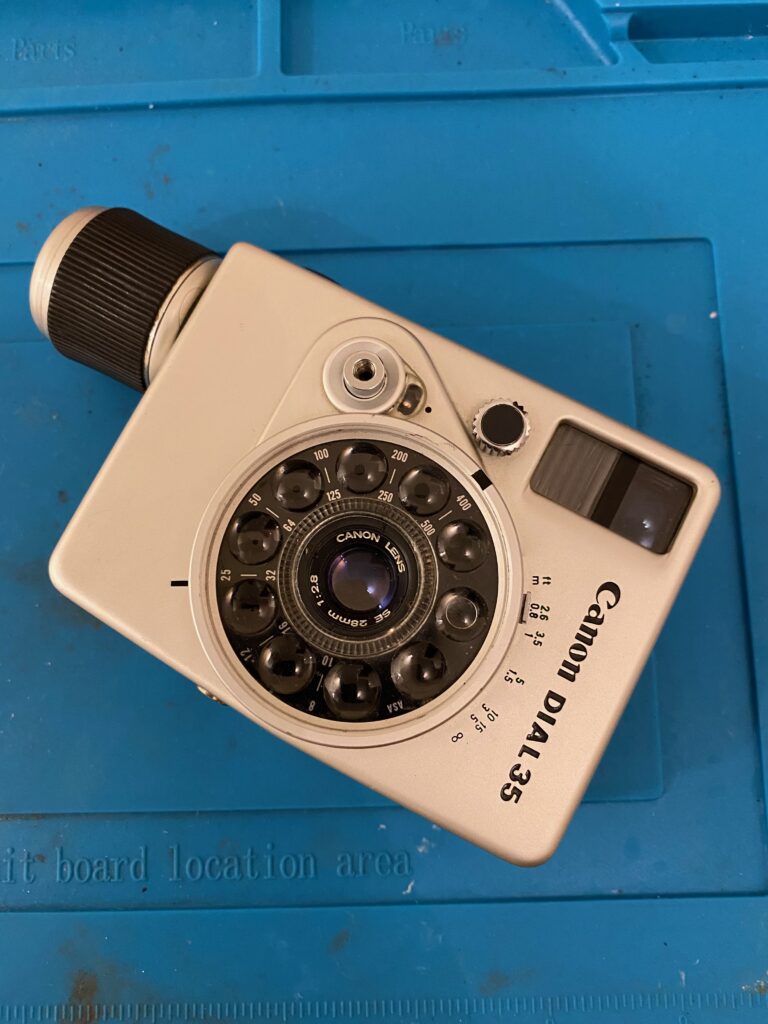
The Dial 35, unlike the Demi, naturally shoots images in a landscape format and is designed to be used with one hand. It was marketed as an action camera due to the fact that once you’ve wound it up it will automatically advance the film and re-cock the shutter ready for the next frame. When it works, it’s surprisingly quick and responsive.
The motor drive in this case works by storing spring tension inside the winding knob itself, this is then transferred through a set of gears into the camera whenever it is needed. On a full wind it seems to be effective for around 20 frames before needing to be wound again. When the film is finished it can then divert this power into rewinding the film but I’m yet to get it to actually pull a whole film back before running out of power and rewinding then becomes manual.
This very complex clockwork operation seems a strange choice when there is also a battery inside which powers the light meter and exposure. In context it makes sense as battery powered motor drives didn’t start to commonly appear on SLR’s and other cameras for another 7-8 years after the launch of the Dial 35.
The usual ebay lies

Prices of the Dial 35 in the UK at the moment are approaching “new trousers” on the price scalp-o-meter. The cheapest “untested” (badly broken) model is £65 as of writing this post. I picked mine up for £30 as the description seemed to think the light meter was faulty but the rest functioned fine. This was, you’ll be shocked to hear, all lies.
Upon arrival, I took the battery out, cleaned the terminal that the battery sits on and the meter instantly started working. You’d think this was a great score, in that case, and I thought the same for all of 5 minutes before I discovered literally nothing else works.
You see the bit about the light seals being replaced? Well, it turns out this meant someone has been waving their screwdrivers about and have been inside this camera very recently. I can’t think why they decided to sell it.
Initially it seemed that the damage included the shutter being jammed, the winder doing nothing and the shutter gear inside the film chamber was stuck. There was more to come, but that’ll do for now.
Luckily, the original Canon service manual is available online for free.
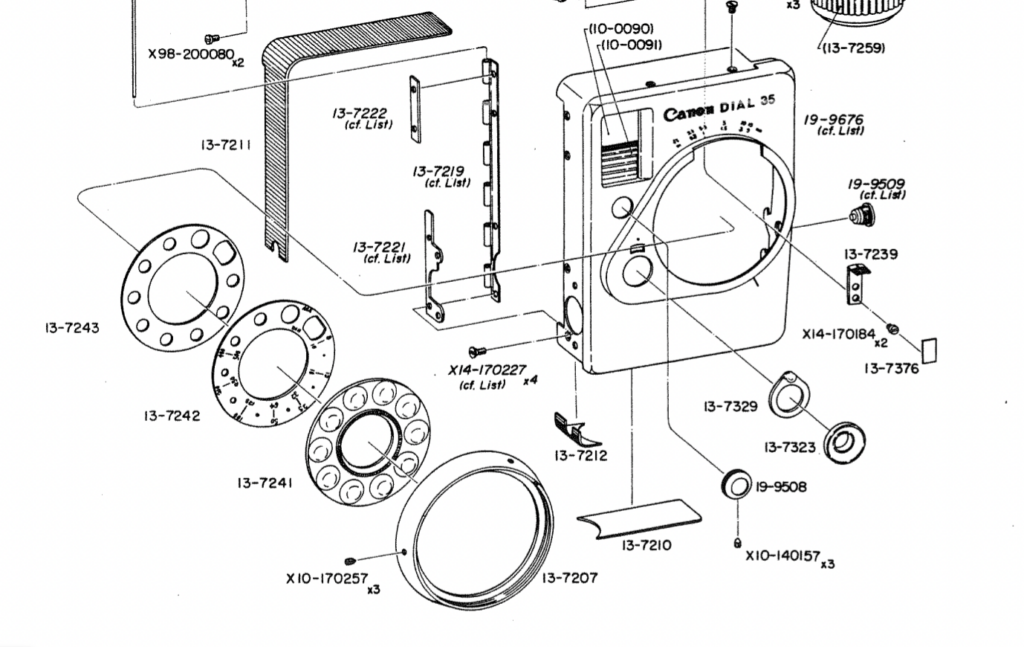
Carefully digging inside the camera two things quickly became apparent – someone had done an awful job of replacing the light seals and secondly, they’d snapped off the wires to the flash socket and instead of fixing it, they’d just smashed them back in the case and screwed it back together anyway.
Worse was to come. When I finally worked out why the shutter wouldn’t fire and learned how the mechanism worked, it showed that this camera never worked and could not have worked once put back together. More signs of high quality work came to light when odd screws started to appear that were not original to the camera.
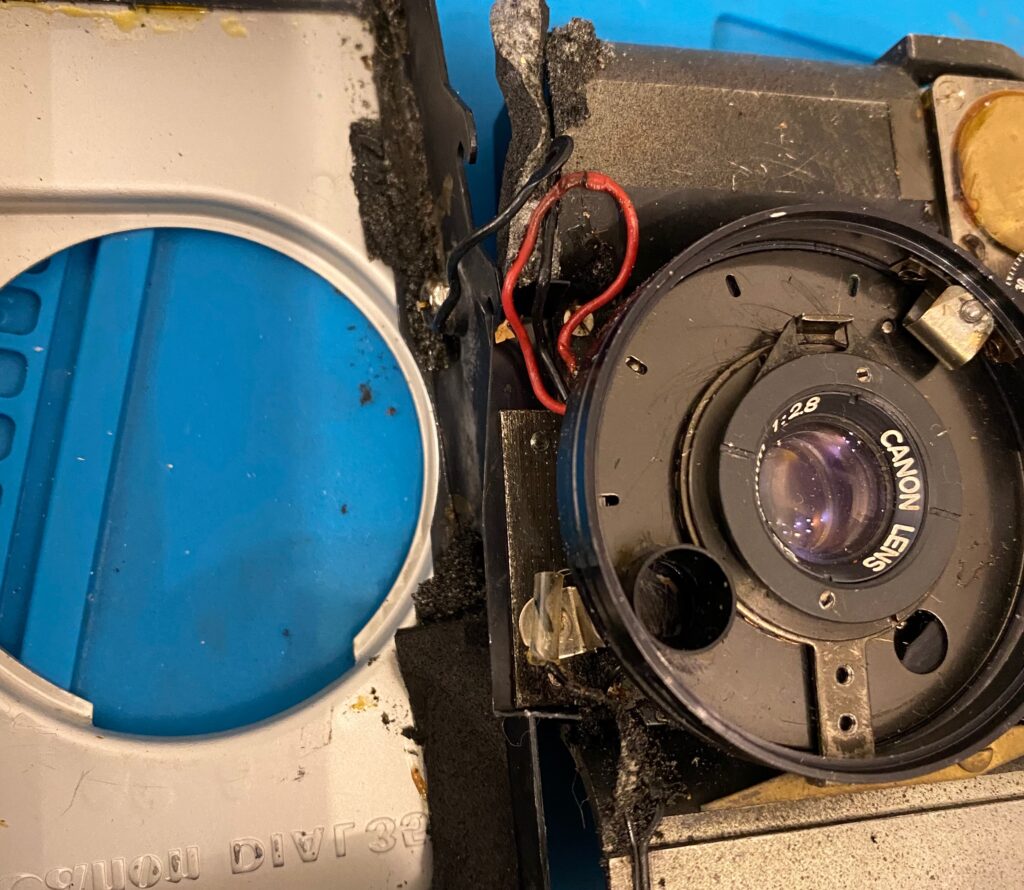
Cleaning someone else’s mess
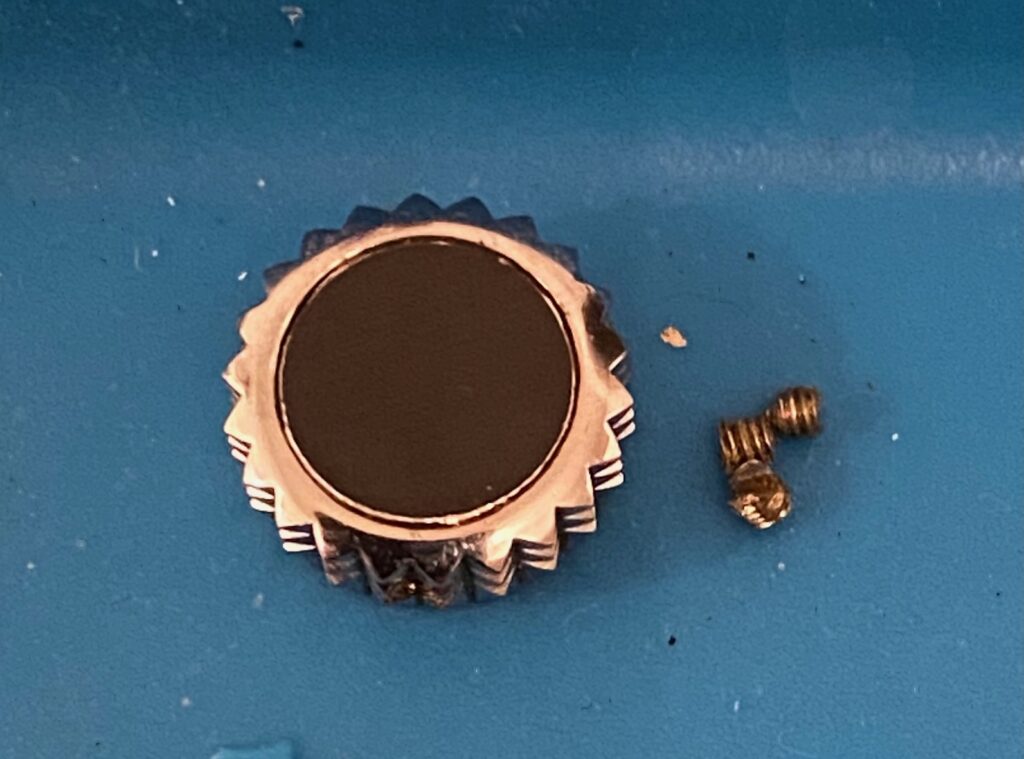
Eventually, I had the camera down to almost a shell with the shutter hanging off. The Dial 35 uses some of the smallest screws I have ever seen, it was more akin to working on a watch than a camera. We’re talking about components that are so small they look like specs of dirt, I’ve never felt so old than I did squinting at the blue mat trying to work out what was a component and what was flakes of dead light seal.
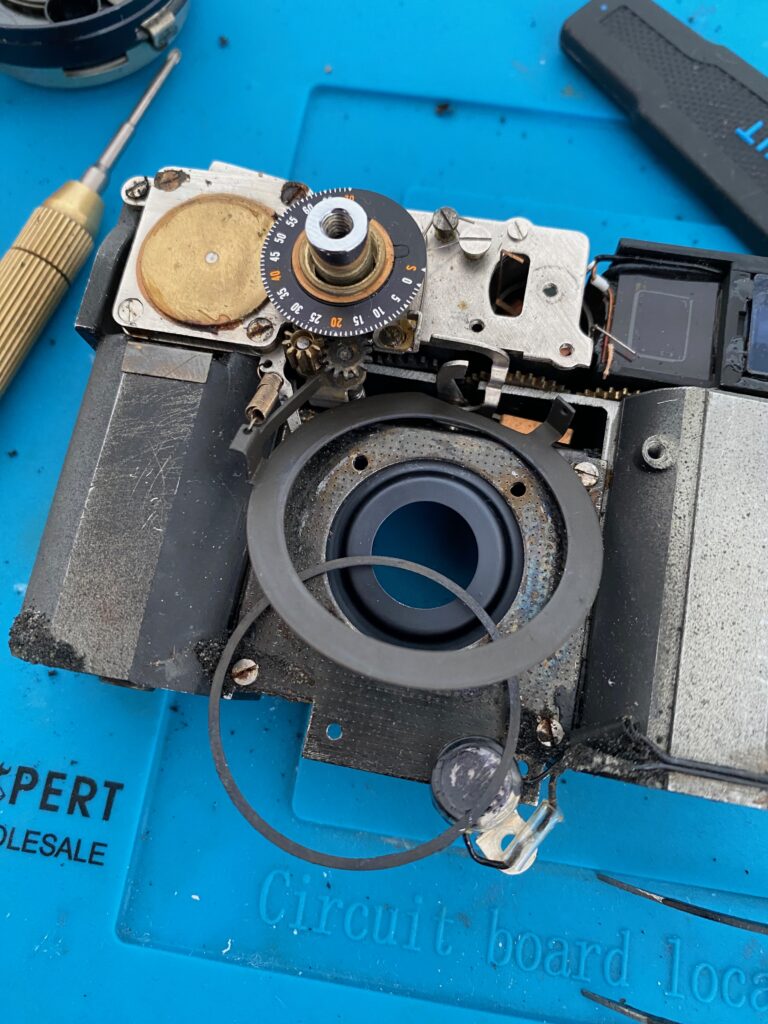
In the picture above you can see the origin of the jammed shutter issue. Right in the middle, at the top, there is a hook shaped lever. This is connected to a cog which protrudes into the film chamber. The film sprockets pull this cog around and this in turn tensions the shutter by moving this lever across the shutter cocking lever. This hook shaped bit must sit to the left of the shutter when it is installed. I’ll give you one guess where it was before I took it apart.
I took the opportunity to clean up those two black metal rings you can see, between them they operate the aperture and fire the shutter when the release is pressed. Finally, you can just see the CDS light sensor at the bottom. Notice that it is covered in some nasty black residue which seemed to be a combination of dead light seal and lubrication. How it was still working, I really do not know, nor do I have any great faith that the light meter on this camera is in any way accurate.
After some really very delicate manoeuvres I managed to re-assemble the Dial 35 and not only did I have zero parts left over, it actually now worked. The wind up mechanism works and holds tension, the shutter fires and having timed them with a slow motion camera, the various shutter speeds seem almost accurate. I’ll call that a win for now.
Conclusions and learning
Having run a test film through it a few times, my copy of the Dial 35 now seems to be fully functional, but it still remains to be seen if there’s anything wrong with it. I’m dubious as to the quality of the readings from the light meter, I’m not convinced the apertures are always what they should be, but there’s only one real way to find out and that’s to put a film through it.
I don’t mind broken things, especially when they’re this old, but I really can’t stand it when someone else has been inside something, mashed it up and left it in a worse state than they found it to be in. I’m on a streak of bad luck when it comes to the inevitable bending of the truth on ebay recently. Fortunately, however, I also seem to be able to recover from some of these situations and I’m learning so much about repair and how cameras work that I’m almost happy about it.
The Dial 35, right now, feels like a quirky step too far in terms of the design. Many people rant and rave about how brilliant it is in their reviews but I’m not convinced by it as yet. However, it must be said that it does seem like a killer street camera because of the motor wind and small form factor. I’ll have to reserve judgement until I’ve actually had the opportunity to use it properly.
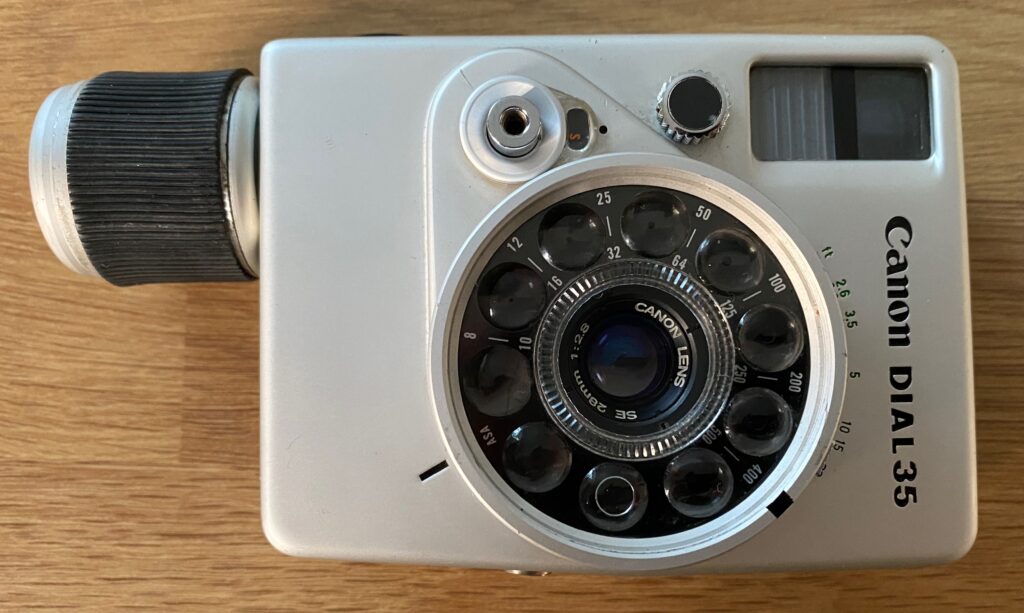
Share this post:



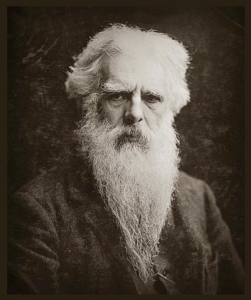
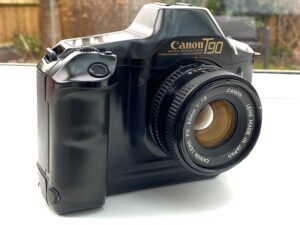
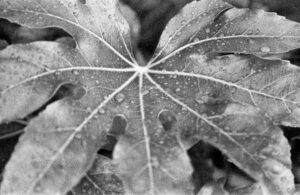


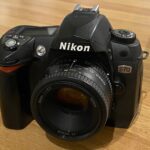

Hello do you repair the Canon dial?
depends what the problem is! If its just the winder, then yes. If it was the shutter I’d be reticent. I managed to damage the meter needle on mine when I had to take it completely apart.
My shutter sticks so I cleaned it with isopropanol and it worked well …until the iso dried. Is there something that I can apply to the leaf shutter to lubricate it in some way so it runs smoothly. Any advice would be gratefully received as I would love to shoot with it.
Generally where alcohol won’t work you need to use lighter fluid, especially on aperture blades, they should never be lubricated with anything – this will make everything stick. The only “lubricant” you might ever use would be graphite based but you shouldn’t really need it if everything is truly clean.
If it is the shutter then it’ll be far more complex – there can be numerous reasons why it won’t fire so more info would be needed for that.
Hopefully that helps.
No, you shall never lubricate shutterblades. To clean them you have to take out the shutter and take it apart for proper cleaning. It should be possible to do it without taking the whole camera apart, take it from the front, guess it will be a little tricky but possible.